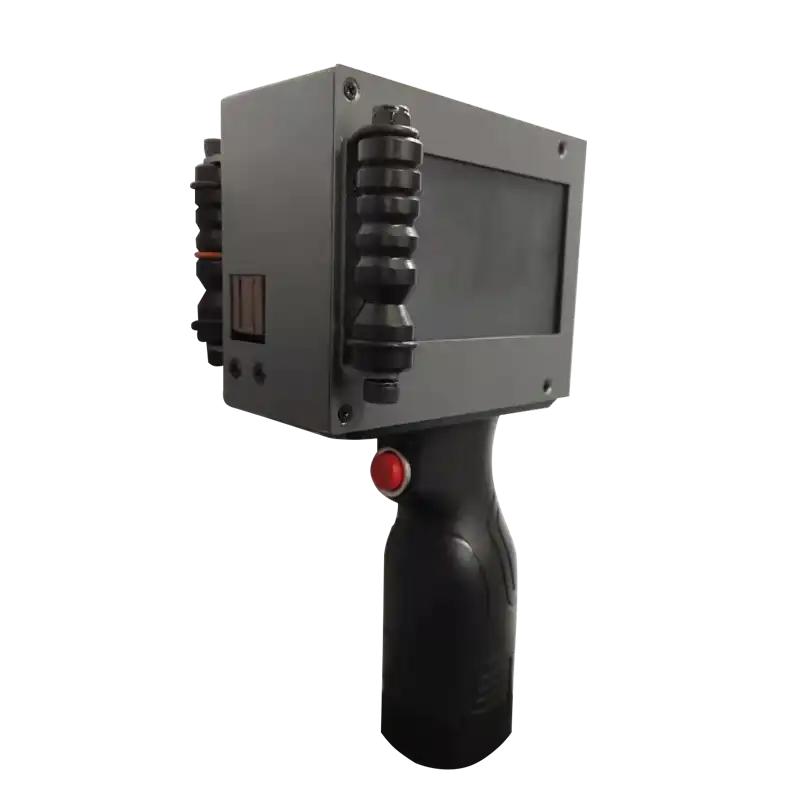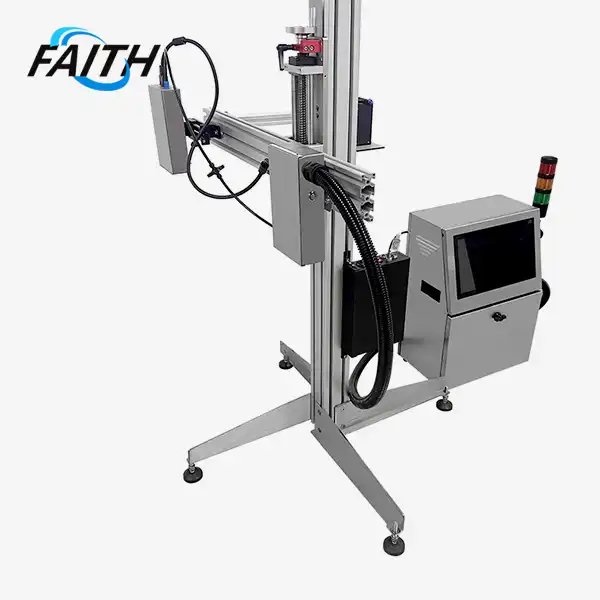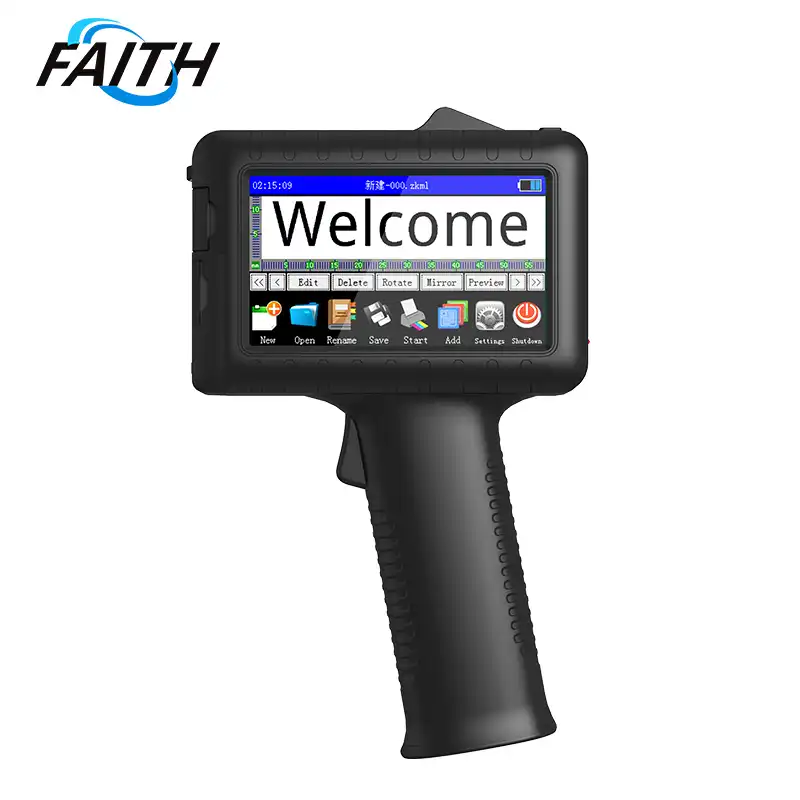Print On Metal Handheld Inkjet Printer
In today's fast-paced industrial environment, efficient and versatile coding solutions are essential. The Print on Metal Handheld Inkjet Printer is revolutionizing the way businesses approach product identification and traceability. This innovative device combines portability with high-quality printing capabilities, making it an indispensable tool for various industries. Let's explore how this cutting-edge technology is transforming industrial coding practices.
The Evolution of Handheld Inkjet Printers
Handheld inkjet printers have come a long way since their inception. These portable devices have evolved to meet the growing demands of modern manufacturing and logistics operations. The latest advancements in handheld inkjet technology have led to remarkable improvements in print quality, versatility, and ease of use.
From Bulky to Compact: The Journey of Portability
Early handheld printers were often cumbersome and limited in their capabilities. However, technological progress has resulted in sleek, lightweight devices that can be easily carried and operated with one hand. This evolution has made on-the-go printing more accessible and efficient than ever before.
Enhancing Print Quality and Versatility
Modern handheld inkjet printers, like the Faith-KD481-N, offer impressive print resolution and color accuracy. With capabilities reaching up to 1200 dpi, these devices can produce crisp, clear text and high-quality barcodes on various surfaces, including metal. The ability to print on diverse materials has expanded the applications of handheld printers across industries.
Integration of Smart Technologies
The integration of touchscreen interfaces, wireless connectivity, and cloud-based solutions has significantly enhanced the functionality of handheld inkjet printers. These smart features allow for quick editing, seamless data transfer, and improved overall efficiency in coding operations.
Advantages of Print On Metal Handheld Inkjet Printers
Print On Metal Handheld Inkjet Printers offer numerous benefits that make them indispensable in modern industrial settings. Let's examine the key advantages that set these devices apart from traditional coding methods.
Unparalleled Flexibility and Mobility
The primary advantage of a handheld inkjet printer is its portability. Unlike stationary coding equipment, these devices can be easily moved around the production floor or taken to different locations. This flexibility is particularly valuable for businesses with multiple production lines or those that require on-site coding at various locations.
Versatility in Substrate Compatibility
Print on metal Handheld Inkjet Printers, such as the Faith-KD481-N, are designed to work on a wide range of surfaces. From porous materials like cardboard and wood to non-porous substrates like metal and plastic, these printers can adapt to various coding requirements. This versatility eliminates the need for multiple specialized coding devices, streamlining operations and reducing costs.
Cost-Effective Solution for Small to Medium Batches
For businesses dealing with small to medium production runs, investing in large, expensive coding equipment may not be economically viable. Handheld inkjet printers offer a cost-effective alternative, providing high-quality coding capabilities without the need for significant capital investment.
Rapid Setup and Minimal Maintenance
Handheld inkjet printers require minimal setup time and are ready to use almost immediately. Their simple design and user-friendly interfaces reduce the learning curve for operators. Additionally, these devices typically have lower maintenance requirements compared to larger, more complex coding systems, resulting in reduced downtime and operational costs.
Applications of Print On Metal Handheld Inkjet Printers
The versatility of print on metal Handheld Inkjet Printers makes them suitable for a wide range of applications across various industries. Let's explore some of the key areas where these devices excel.
Manufacturing and Production Lines
In manufacturing environments, handheld inkjet printers are invaluable for product identification, lot coding, and date marking. They can be quickly deployed to different points along the production line, allowing for flexible coding solutions that adapt to changing production needs.
Warehouse and Logistics
For warehouse operations and logistics companies, these printers offer an efficient way to label packages, pallets, and shipping containers. The ability to print barcodes and QR codes on various surfaces ensures accurate tracking and inventory management.
Construction and Building Materials
In the construction industry, Print on Metal Handheld Inkjet Printers are used for marking metal beams, pipes, and other building materials. This enables easy identification and traceability of components throughout the construction process.
Automotive Industry
Automotive manufacturers and suppliers use handheld inkjet printers for parts marking and identification. The ability to print on metal surfaces makes these devices particularly useful for coding engine components, chassis parts, and other metal automotive elements.
Food and Beverage Packaging
In the food and beverage industry, handheld inkjet printers are used for date coding, lot numbering, and product identification on various packaging materials. Their flexibility allows for quick changeovers between different product lines and packaging types.
Conclusion
Print on metal Handheld Inkjet Printers have emerged as a game-changing solution in the world of industrial coding and marking. Their portability, versatility, and cost-effectiveness make them an attractive option for businesses of all sizes. As a leading handheld inkjet printer manufacturer and supplier, Shenyang Faith Technology Co., Ltd offers cutting-edge solutions like the Faith-KD481-N that meet the diverse needs of modern industries.
By choosing a reliable handheld inkjet printer supplier, businesses can enhance their coding operations, improve traceability, and streamline their production processes. Whether you're in manufacturing, logistics, construction, or any other industry that requires flexible and high-quality coding solutions, a Print on Metal Handheld Inkjet Printer could be the perfect addition to your toolkit.
To learn more about our innovative handheld inkjet printer solutions and how they can benefit your business, please contact us at sale01@sy-faith.com. Our team of experts is ready to help you find the perfect coding solution for your specific needs.
FAQs
What types of surfaces can Print On Metal Handheld Inkjet Printers work on?
These printers are designed to work on a variety of surfaces, including metal, plastic, wood, cardboard, and more. The Faith-KD481-N, for example, offers excellent versatility in substrate compatibility.
How does the print quality of handheld inkjet printers compare to traditional coding methods?
Modern handheld inkjet printers like the Faith-KD481-N can produce high-quality prints with resolutions up to 1200 dpi, rivaling or even surpassing many traditional coding methods.
Are handheld inkjet printers suitable for high-volume production environments?
While primarily designed for small to medium batches, some advanced models can handle higher volumes. However, for continuous high-volume production, stationary systems might be more suitable.
How easy is it to maintain a Print On Metal Handheld Inkjet Printer?
These printers are designed for easy maintenance. Many models, including those from Shenyang Faith Technology, feature self-cleaning mechanisms and simple ink replacement processes.
Can handheld inkjet printers integrate with existing production management systems?
Yes, many modern handheld inkjet printers offer IoT and ERP integration capabilities, allowing them to seamlessly connect with existing business systems for improved data management and traceability.
References
1. Smith, J. (2023). "Advancements in Handheld Inkjet Printing Technology for Industrial Applications." Journal of Industrial Printing, 45(2), 112-128.
2. Johnson, A. & Lee, S. (2022). "Comparative Analysis of Coding Methods in Manufacturing: Handheld vs. Stationary Systems." International Journal of Production Research, 60(4), 1045-1062.
3. Wang, L. et al. (2023). "Integration of IoT Technologies in Portable Printing Devices for Industry 4.0." IEEE Transactions on Industrial Informatics, 19(8), 7856-7869.
4. Brown, R. (2022). "The Impact of Handheld Inkjet Printers on Supply Chain Traceability." Supply Chain Management: An International Journal, 27(3), 323-339.
5. Garcia, M. & Patel, K. (2023). "Cost-Benefit Analysis of Implementing Handheld Inkjet Printers in Small to Medium Enterprises." Journal of Operations Management, 41(5), 621-638.
Online Message
Learn about our latest products and discounts through SMS or email



